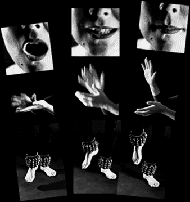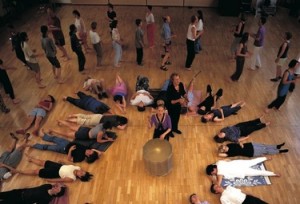
TaKeTiNa is a dynamic and
meditative group
process for people who want to develop their awareness of rhythm or of self.
As a music-education tool, TaKeTiNa is a uniquely effective, individually-paced kinesthetic process that works equally well whether you’re a professional musician or can’t whistle a tune.
As a wellness modality, TaKeTiNa has research-proven health benefits including deep relaxation, stress relief, and right-brain/left-brain integration.
In TaKeTiNa, participants are guided in a series of interactive rhythmic journeys – stepping, clapping, and vocalizing –that allow your mind to become quiet while your body reconnects with its innate wisdom of natural rhythmic laws. The rhythm and movement provide a vehicle for an active meditation through which profound healing and self-discovery can occur.
 TaKeTiNa is not about linearly learning to do something right. It is a non-linear process in which we are guided into alternately finding and losing our orientation, both actively and passively being in rhythm. In such a space, we can explore the fluctuation between confusion and clarity, chaos and order, the known and the unknown. From the inside and in our own time, we begin to sense shifts in our very relationship to time and space.
TaKeTiNa is not about linearly learning to do something right. It is a non-linear process in which we are guided into alternately finding and losing our orientation, both actively and passively being in rhythm. In such a space, we can explore the fluctuation between confusion and clarity, chaos and order, the known and the unknown. From the inside and in our own time, we begin to sense shifts in our very relationship to time and space.
TaKeTiNa has been established in Europe for 40 years. It is part of the curriculum at music conservatories and is used therapeutically in hospitals, pain management clinics, mental health and drug rehabilitation programs.
Benefits of TaKeTiNa in the realm of music:
- play with groove and flow
- develop profound rhythmic orientation
- get to know universal rhythmic building blocks
- learn to improvise and to compose
- develop competence on drums and percussion instruments.
Benefits of TaKeTiNa in the Realm of Daily Life
- learn to deeply relax
- learn to stay focused over a long period of time
- learn to deal with complexity in a creative and effective way
- release the fear of making mistakes – which allows you to make fewer mistakes
 Amy Jackson 404.784.2462
Amy Jackson 404.784.2462